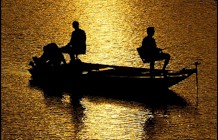The most popular game fish
at Toledo Bend Reservoir is the largemouth bass; an excellent year-round
fishery exists. Good year-round crappie and catfish fisheries are also
present. Striped bass are maintained by annual stockings because
conditions at Toledo Bend usually do not allow a successful natural
spawn. Stripers are popular due to their large growth potential and
reputation as strong fighters. Bluegill and redear sunfish are present
in high numbers and provide excellent fishing, especially for youth or
inexperienced anglers.
FISHING COVER/STRUCTURE
Habitat in Toledo Bend Reservoir consists
of aquatic vegetation, standing timber, and flooded terrestrial
vegetation. Hydrilla is the predominant plant species, although many
native plants (coontail, eelgrass, pondweed, lily pads) are also
present. In the lower part of the reservoir the water is typically
clear; gamefish are usually found around vegetation edges, flats, humps,
and creek channels. In the upper third of the reservoir, the abundance
of vegetation typically declines. Timber, brush, laydowns, and creek
channels provide upper-lake gamefish habitat. At periods of high water,
terrestrial bushes and trees provide excellent habitat reservoir-wide.
Tips & Tactics
Anglers are most successful at catching largemouth bass
during the fall, winter, and spring months. Due to cooler water
temperatures, fish are active for longer periods of the day and are
typically found in shallow water. A variety of baits and techniques will
work during these times. When fish are active, crankbaits and
spinnerbaits are usually the preferred choice. During the hot summer,
the bite slows and fish activity is usually concentrated during early
morning, late evening, and at night. Poppers, propeller baits,
stickbaits, buzzbaits, and flukes are good topwater choices during low
light conditions. As the sun rises, most bass concentrate in or around
vegetation edges, or seek refuge on deep ledges and creek channels.
During this time, plastic worms and jigs are the preferred baits.
Crappie fishing is good year-round with jigs and
minnows. However, fishing usually peaks during the spring spawn, when
anglers target shallow areas around vegetation. During other times of
the year, fish are typically concentrated in deeper water around
brushpiles and creek channels. Anglers catch channel, blue, and
flathead catfish throughout the reservoir. Channel catfish can
be caught with stinkbait in areas baited with soured grain. Trotliners
catch both blues and channels on cut bait, while flathead catfish prefer
live bait.
The white bass fishery is essentially limited to the
early spring during the spawning run above the reservoir. Anglers have
good success with small spinners, jigs, jigging spoons, and small
crankbaits. During the summer and fall, watch for schooling
striped bass on main lake points, humps, and flats adjoining
river channels. Schooling stripers can be caught on topwaters, rattle
traps, and spoons. Toledo Bend has a reputation for producing lots of
huge sunfish. Most of the bigger sunfish, especially
bluegill and redear sunfish, are caught during the late spring or summer
when fish are on spawning beds. Small jigs, spinners, and crickets are
good choices.
Location: On the
Sabine River in Shelby, Sabine and Newton counties, straddling the
Texas-Louisiana state line. The dam is in Newton County approximately 24
miles northeast of Jasper.
Size: 185,000 acres
Maximum Depth: 110
feet
Date Impounded: 1967
Normal Water Clarity:
Clear in middle and lower lake to slightly turbid in upper region
Water Level Fluctuation:
1-5 feet
Conservation Pool
Elevation: 172 ft. msl
Current Water Levels
Aquatic Vegetation:
Primarily non-native submersed plants such as hydrilla; a variety of
native aquatic plants are also established





